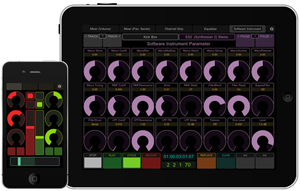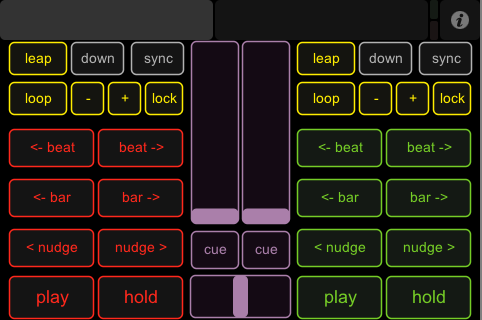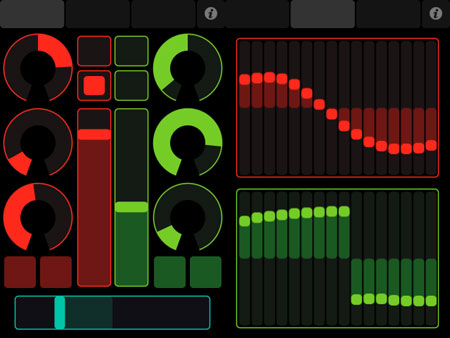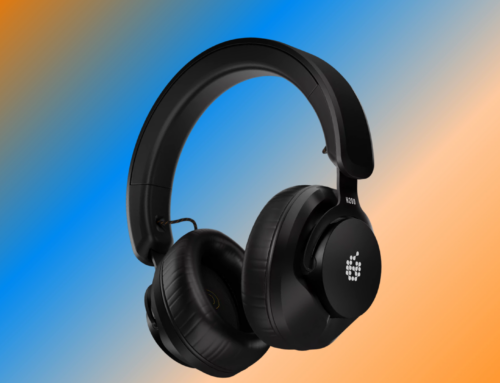 I’ve cycled through every locker room halftime speech I could think of in trying to give this review the aura it deserves, but in the end nothing seemed to fit quite right. Sure, I want to motivate. Sure I want you to take your practice more seriously. So why, then, didn’t the Gordon Bombay approach feel right? Because as much as I want to give you the tools and knowledge you need to elevate your game, I can’t guarantee this is what you need to take your sound to the next level. A new tool is only as good as the hand that wields it. And for some, TouchOSC could be a kind of better, stronger hammer–replacing the one you already use–but for most it’s more than that. For most it’s about adopting and embracing the desire to take one’s sound to that next level. Gotta want it, kid.
I’ve cycled through every locker room halftime speech I could think of in trying to give this review the aura it deserves, but in the end nothing seemed to fit quite right. Sure, I want to motivate. Sure I want you to take your practice more seriously. So why, then, didn’t the Gordon Bombay approach feel right? Because as much as I want to give you the tools and knowledge you need to elevate your game, I can’t guarantee this is what you need to take your sound to the next level. A new tool is only as good as the hand that wields it. And for some, TouchOSC could be a kind of better, stronger hammer–replacing the one you already use–but for most it’s more than that. For most it’s about adopting and embracing the desire to take one’s sound to that next level. Gotta want it, kid.
I’d venture to say that at this stage of the game we can all accept the fact that every minute it’s becoming easier (and more likely) for your neighbor to call himself a DJ. The market is inundated with Autosync’d, beatmatchers. Compatible-Song-crate-toting ten-year-olds are becoming the norm, and this is NOT going to change. Now, I don’t see them taking your gigs any time soon– they’ve got eleven years until they’re allowed up in da club–but with all kinds of new and powerful software hitting the market and being updated constantly, we’re going to see a mass of capable amateurs flooding the scene, and that is inevitably going to affect the way we seasoned professionals have to approach both building and implementing an up-to-date setup, and maintaining originality and control when producing–live and in the studio.
At this point, you’re asking yourself what the hell your coach is talking about, and that’s okay. He’s getting to the point now: TouchOSC is an incredibly open-ended and powerful application. It marks a brilliant step forward for the world of DJing, and if you don’t embrace it, you WILL be left behind.
Am I saying that if you don’t use TouchOSC you’re not going to find success as a DJ? No. I ain’t that dumb, cuz.
What I am saying is that you might be well-advised to start exploring the way new technologies allow us to streamline what we already do live and make it more comfortable. Any kid with a laptop nowadays can throw on Funky Cold Medina and roll through a whole set seamlessly without knowing what he’s doing. And yeah, he’s not using timecode. His set might not be diverse. He may not be considering the way he’s working harmonically. But to the clubrats, it’s all the same. Or is it?

In any sport, there’s something to be said for those who play the game well by playing it differently. If we understand the way the technology around us is being developed for the sake of making our lives easier, of giving us more control, we can embrace new tools as they suit our needs.
‘Sensei, why all this motivational talk?’ you ask? It’s because I have no doubt TouchOSC has the ability to revolutionize your practice and make you a better DJ. You going to the App Store and buying the thing, well, it says something. It says something about you. It says–you are the kind of guy that takes his sound seriously, that is interested in creating and using a customized controller because you know that even though it will take some getting used to, you’ll be a more original, capable, and in-control DJ–one that looks damn good doin’ his thang, too.
 It’s about experimentation. It’s about designing a signature sound and style–be it by chaining effects and controlling special parameters or by playing with cues and cuttin’n’slicin’. Using TouchOSC you are limited only by your imagination. You have the freedom to experiment with any kind of controller your lil brain can conjure up. Play around with it. See how it looks on your set. And if it’s no good? If it don’t feel quite right? Scrap it. Make a new one. It’s the gift that keeps on giving in that way. Sure, it’s $5. And sure you can spend more on templates and mappings for other applications. But you don’t have to. You always have the option to DIY.
It’s about experimentation. It’s about designing a signature sound and style–be it by chaining effects and controlling special parameters or by playing with cues and cuttin’n’slicin’. Using TouchOSC you are limited only by your imagination. You have the freedom to experiment with any kind of controller your lil brain can conjure up. Play around with it. See how it looks on your set. And if it’s no good? If it don’t feel quite right? Scrap it. Make a new one. It’s the gift that keeps on giving in that way. Sure, it’s $5. And sure you can spend more on templates and mappings for other applications. But you don’t have to. You always have the option to DIY.
I mean, think about it. You want to try out an APC-40 to see how it feels, to see what the plug-n-play features are like out the gate? That’s $300. Not to mention the cost of gas, fare, and/or sweat and tears dealing with getting to your local Guitar Center and maneuvering through that sea of chumps. Now you can pick up your iPad and grab LiveControl–a free mapping for Ableton that works with TouchOSC, and without even missing a bite of your sandwich you’re up and running.
TouchOSC works by sending and receiving Open Sound Control messages. What’s that mean? It means that any software or hardware using OSC or MIDI protocols is fair game. Make a button. Map it. BAM! You have every kind of knob, fader, toggle, multi-push-style button to choose from AND you can map X-Y pads AND you can use accelerometer data too! The app comes with a default layout but using the OSC Editor (free) you can make your own. It’s easy to use. Before you know it you’ll be literally movin’ and shakin’ your way to building that massive Tiesto climax before you drop it on the whole club at once. It’s a thing of beauty.
Now, in the interest of not contradicting myself (and not being such a Positive Panda), I have to acknowledge that TouchOSC does send those OSC messages over WiFi. I addressed this issue in an article last week about Wireless DJ–an app that also works over WiFi–noting that I would not feel totally comfortable relying on a venue’s router. It makes me feel itchy and like I’m not in control. I don’t like to feel itchy and not-in-control. So it is problematic in that sense. At the same time, this #whitegirlproblem is a temporary one. WiFi will indeed reach a point where we can rely on it. We will reach a day when we can put our set/life in the hands of our router and not skip a beat. That said, whether we’re there yet or not, TouchOSC isn’t special because it works wirelessly. It’s special because it is the Übercontroller.
 As an open source piece of software, TouchOSC will provide the platform for building and hosting every digital version of every piece of hardware available. No matter what you’re used to using, there will be a touchpad version of it. Get used to it! Give it a try. At least be open to it. It’s not going to feel the same. It never will. But that doesn’t mean it can’t be better. What if jumping between controllers is something that opens up a world of new sounds and techniques for you as a DJ? You might not ever know without the flexibility TouchOSC allows.
As an open source piece of software, TouchOSC will provide the platform for building and hosting every digital version of every piece of hardware available. No matter what you’re used to using, there will be a touchpad version of it. Get used to it! Give it a try. At least be open to it. It’s not going to feel the same. It never will. But that doesn’t mean it can’t be better. What if jumping between controllers is something that opens up a world of new sounds and techniques for you as a DJ? You might not ever know without the flexibility TouchOSC allows.
Embracing TouchOSC could very well mark a turning point for your practice as a DJ and producer. Taking the time to play with new interfaces, try out new methods, experiment with new avenues for creating and shaping sound–these pursuits are what separate the men from the boys–the auto-cats from the serato-rats–the amateurs from the professionals. Yep, it’s a stretch, but you see where I’m going with it. If you take your practice seriously–it’s about way more than your crates and playlists. It’s about being a pioneer and exploring new frontiers.
Horace Greeley was a real old school cat that edited the most influential newspaper of his day–The New York Tribune. He often pushed his own political agendas as part of what he let go to print and after all my searching for the perfect halftime speech I realized I was looking in the wrong place. Greeley used to openly address the youth of a budding America, urging them to leave the East Coast, no matter how uncomfortable the idea seemed. DJ Manifest Destiny would’ve been what they’d have called him, because he saw potential in pushing the boundaries, in exploring new territory. And now, no more than 150 years later, I am stealing that name, and encouraging all of you budding DJs to take some chances. Step outside your comfort zone and open up your sound for the sake of experimentation. For the love of God, FAIL! Technology has lovingly beget a world where we DJs have the option of never fumbling–we have at our disposal algorithms that took years to develop that render the human element virtually useless. It’s time we took responsibility for this shift. We have to acknowledge and embrace the changing tides so we can ride this wave all the way to the opposite coast.




